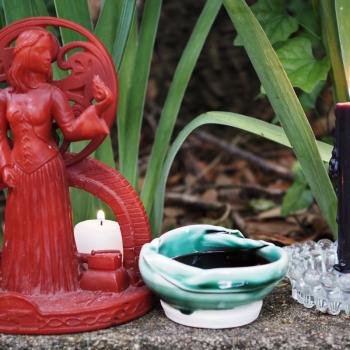Boedromion 16, the sixth day of Full Moon and the second day of the Mysreries, begins at sunset tonight. Note, when we get there, that the full initiation takes place on days 10 and 9 of the Waning Moon (these days were counted down), since chthonian deities, such as Hades, Persephone, and Hekate, were worshipped during the Waning Moon.
Today is also the Synoekia, a sacrifice of two oxen to Zeus Phratrios and Athena Phratria, “of the clans.”
On this day the cry is Haladay mustai, “Initiates, to the sea!” (Clinton, Personnel of the Eleusian Mysteries, p. 13, argues that the term muesis originally referred to the preliminary instruction, or catechesis, which could be given at any time during the year by any member of the Eumolpidai or Kerykes families, who were the hereditary priesthood of Eleusis; this was not an initiation, but quite parallel to the guidelines that any Witch would now give to a newcomer before bringing him or her to a circle. The final ritual of the Mysteries was the telete, which took place in the sanctuary of the Telesterion, performed by the Eleusinian priests and priestesses, only once a year. Thus mustai would be better translated as “catechists” than as “initiates,” and telete does have the sense of completion.)
All who are going to be initiated must walk the six miles to Piraeus, driving a piglet before them, be purified in the sea with the pig, then drive it back to Athens (Plutarch, Phocion, 27,3). The day’s events will not be overly dignified.
It was to this day that Athenaeus (13, 590) referred when he wrote, “Phryne [a famous courtesan] was even more beautiful in her unseen parts. . . . At the great assembly of the Eleusinia and at the festival of Poseidon, in full sight of the whole Greek world, she removed her cloak and let down her long hair before she stepped into the water. It was she whom Apelles took as the model for his `Aphrodite Rising from the Sea.'” It thus seems that the mustai, both men and women, bathed skyclad in the sea, an otherwise impossible event in that misogynistic society, in which respectable women were kept in purdah and only slave girls went shopping, but breaking the ordinary taboos is an earmark of all efficacious initiations. (This passage is especially valuable in proving Aphrodite’s connection with the Mysteries.) Clement of Alexandria (Protreptikos, 2.13), in discussing the Mysteries, begins with Aphrodite, saying, “a cake of salt and a phallus are given to the mustai, . . . who bring the tribute of a coin to the Goddess, as lovers do to a mistress.” (On the events of this day in general, see Harrison, Prolegomena, pp. 152-4.)
Before I get farther into the details of the Mysteries, I’m going to throw in some information that, as far as I know, no one else has mentioned recently. In about 1971, reading through Jane Ellen Harrison’s Prolegomena to a Study of Greek Religion, I ran into a passage she took from the writings of Michael Psellus, a fourteenth-century Byzantine scholar, who had access to documents that have subsequently perished. (Back then, I read the physical book. Today, I pulled up the Google digital text, looked in the index, and found the passage. The URL is http://archive.org/stream/prolegomenatostu00harr#page/568/mode/2up. It’s a different universe.)
Harrison writes (I have inserted the numbering for ease of reference), “Late authors in describing the Eleusinian rites constantly use the vocabulary of the stage. Take the account of Psellus [here Harrison inserts a footnote giving the Greek text that Psellus wrote], . . .
‘the mysteries . . . for example those of Eleusis, enact the double story of Deo or Demeter and her daughter Pherephatta or Kore. (1) As in the rite of initiation love affairs are to take place, Aphrodite of the Sea is represented as uprising. (2) Next there is the wedding rite for Kore, and the initiated sing as an accompaniment, “I have eaten from the timbrel, I have drunk from the cymbals, I have carried the kernos, I have gone down into the bridal chamber.” (3) Then also they enact the birth-pains of Deo. At least there are the cries of entreaty of Deo, the draught of gall, and the cries of pain. (4) Next is a goat-legged mime because of what Zeus did to Demeter. (5) After all this there are the rites of Dionysus and the cista and the cakes with many bosses and the initiated to Sabazios and the Klodones and Mimallones who do the rite of the Mother and the sounding cauldron of Thesprotia and the gong of Dodona and a Korybas and a Koure, separate figures, mimicing forms of demons.’”
At this point Harrison stops translating Psellus and adds (6)”After this is the action of Baubo.” Harrison, being a proper Victorian lady, adds a footnote saying, “The account of Psellus is for obvious reasons resumed rather than translated,” meaning it was even more graphic about something having to do with sex, but her reasons were not obvious. It was at this moment I realized that I had to learn Greek, which I had proceeded to do before I began my doctoral program in January 1974.
The problem with this passage from Psellus is that it is very detailed and clearly derived from some earlier source that has not survived, but the sequence of actions it describes is totally unlike what we can piece together from all other sources. It does not appear to be just a fantasy, and it does connect in many ways with other information about the Mysteries, just not in that sequence. Was it reliable information or not?
Somewhere in the mid-1970s I leaped to a hypothesis about the passage: what Psellus was copying was someone’s description of a series of bas reliefs, but Psellus did not know that; he thought the document was describing what was done in the Eleusinian ritual itself. Perhaps Harrison thought that also. She, like the other classic classicists of her generation, had introduced the concept that there were three major ways of representing mythology in a religious context: as legomena (the things said), as dromena (the things done), and as deiknumena (the things shown). There is never a one-to-one correspondence between things said and things done; this is evident for everything we know about Semitic and Greek religion in general. Likewise, there isn’t a one-to-one correspondence between things done and things shown; the relationships are far more complex.
I was working with Joseph Fontenrose, the retired chair of the Classics department at UC Berkeley, who agreed that my hypothesis was reasonable—even though he found me to be very puzzling and somewhat of a loon, he gave me a “High Pass” on my doctoral comprehensive exam on the cultus of Demeter. He was also an old Socialist and had spearheaded the UC faculty’s fight against McCarthyism in the ‘50s and ‘60s.
Here I will present some discussion of what the bas reliefs may have looked lik. Iwill point out where they seem to link into the events of the Mysteries as we go along.
First, Psellus says,. (1)” As in the rite of initiation love affairs are to take place, Aphrodite of the Sea is represented as uprising.” That icon must have been much like the well-known panel on the Ludovisi Throne (which unfortunately I cannot copy here. So look it up).
It plainly links with the comment that Phryne, a courtesan, was the model for Apelles’ statue of Aphrodite. But love affairs as part of the initiation? Something like the Great Rite? That would be fine with Witches, but there are few indications that the Mysteries involved sexual initiation—except for Asterius’ dubious assertion about “”the underground chamber and the solemn meeting of the hierophant and the priestess, each with the other alone, when the torches are extinguished, and the vast crowd believes that its salvation depends on what goes on there.” Few have taken this possibility seriously, but given the origin of the Eleusinia at about 1500 BCE and the well-known Mesopotamian ritual of the sacred marriage between the king and the priestess who embodied the sovereignty of the land, which dates back to that era, it is possible that such a ritual may have been one of the as-yet undeciphered secrets of Eleusis.
For icon (2), we have no indication that the wedding of Hades and Persephone, at which Zeus gave her the island of Sicily as a wedding present, was enacted during the Mysteries; yet this ties into the issue of the sacred marriage. The ritual formula that Psellus cites is also given by Clement in his Protreptikos, from where Psellus might have retrieved it, since it would not likely have been engraved on a bas relief.
Icon (3) must have shown a woman giving birth, here interpreted as Demeter giving birth to Kore.
Icon (4) apparently portrayed a satyr play, which were always bawdy, about the sex act, here interpreted as Zeus’ fathering Kore on Demeter.
Icon (5) may have actually comprised several bas reliefs, since it is hard to imagine how all these elements would fit into one picture. Clearly it showed many round objects, which Psellus relates to Clement’s description of the ritual objects used in the Mysteries, along with much dancing. However, some of the ritual scenes on some Greek vases were this complicated.
Icon (6) is not very mysterious after all. It showed the “action of Baubo,” who, as described in the Second Homeric Hymn to Demeter, which was the official myth of Eleusis, exposed her shaven genitals to the mourning Demeter, thus persuading Demeter to laugh and drink the “kykeon” tea. It may have been similar to the Shiela-na-Gig figures of Celtic countries. The Greek “baubo” was the name for what we call a dildo, and Baubo was the traditional clown who entertained the initiates at the Kephisos bridge with bawdy jokes.
Overall, these icons seem to reveal a sexual meaning to the Mysteries that is anything but obvious from other sources. Perhaps it was originally there, since the Eleusinia certainly began as a rural fertility festival, before they were reinterpreted by the author of the Hymn to Demeter during the worldwide religious renaissance of the seventh century BCE (a topic for a different essay). Perhaps that meaning was suppressed by the prudery that had developed by the age of Pericles and that was adopted as a new and heretical doctrine as Christianity expanded out into the Hellenistic world.
However, much as I enjoy speculating, that’s enough for now. I will refer back to these icons as they become relevant to later days during the celebration of the Mysteries.












